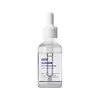What's inside
What's inside
 Key Ingredients
Key Ingredients

 Benefits
Benefits

 Concerns
Concerns

No concerns
 Ingredients Side-by-side
Ingredients Side-by-side

Water
Skin ConditioningGlycerin
HumectantButylene Glycol
HumectantPropanediol
Solvent1,2-Hexanediol
Skin ConditioningHydrolyzed Lupine Protein
Skin ConditioningAcetyl Hexapeptide-8
HumectantTripeptide-3
Skin ConditioningAcetyl Octapeptide-3
HumectantCopper Tripeptide-1
Skin ConditioningPalmitoyl Pentapeptide-4
Skin ConditioningPalmitoyl Tetrapeptide-7
Skin ConditioningPalmitoyl Tripeptide-1
Skin ConditioningTripeptide-1
Skin ConditioningTripeptide-2
Skin ConditioningAdenosine
Skin ConditioningGluconolactone
Skin ConditioningCollagen
MoisturisingHydrolyzed Collagen
EmollientLeuconostoc/Radish Root Ferment Filtrate
AntimicrobialSodium Hyaluronate
HumectantHydroxyacetophenone
AntioxidantCarbomer
Emulsion StabilisingCellulose Gum
Emulsion StabilisingTromethamine
BufferingBetaine
HumectantXanthan Gum
EmulsifyingEthylhexylglycerin
Skin ConditioningHydrolyzed Gardenia Florida Extract
AntioxidantHydrolyzed Malt Extract
Skin ConditioningHydrolyzed Viola Tricolor Extract
Skin ProtectingDisodium EDTA
Water, Glycerin, Butylene Glycol, Propanediol, 1,2-Hexanediol, Hydrolyzed Lupine Protein, Acetyl Hexapeptide-8, Tripeptide-3, Acetyl Octapeptide-3, Copper Tripeptide-1, Palmitoyl Pentapeptide-4, Palmitoyl Tetrapeptide-7, Palmitoyl Tripeptide-1, Tripeptide-1, Tripeptide-2, Adenosine, Gluconolactone, Collagen, Hydrolyzed Collagen, Leuconostoc/Radish Root Ferment Filtrate, Sodium Hyaluronate, Hydroxyacetophenone, Carbomer, Cellulose Gum, Tromethamine, Betaine, Xanthan Gum, Ethylhexylglycerin, Hydrolyzed Gardenia Florida Extract, Hydrolyzed Malt Extract, Hydrolyzed Viola Tricolor Extract, Disodium EDTA
Water
Skin ConditioningGlycerin
HumectantHydrolyzed Yeast Extract
Skin ConditioningPentylene Glycol
Skin ConditioningTamarindus Indica Seed Gum
Emulsion StabilisingSodium Hyaluronate Crosspolymer
HumectantPalmitoyl Tripeptide-38
Skin ConditioningMyristoyl Nonapeptide-3
Skin ConditioningCopper Lysinate/Prolinate
Skin ConditioningMethylglucoside Phosphate
Skin ConditioningHydrolyzed Sodium Hyaluronate
Skin ConditioningSodium Hyaluronate
HumectantAhnfeltia Concinna Extract
Skin ConditioningSaccharide Isomerate
HumectantPolyglucuronic Acid
Skin ConditioningLactobacillus/Eriodictyon Californicum Ferment Extract
Skin ConditioningPseudoalteromonas Ferment Extract
HumectantPhospholipids
Skin ConditioningLecithin
EmollientHydroxypropyl Cyclodextrin
MaskingCetyl Hydroxyethylcellulose
Emulsion StabilisingPolyacrylate Crosspolymer-6
Emulsion StabilisingHexylene Glycol
EmulsifyingSalicylic Acid
MaskingCitric Acid
BufferingSodium Citrate
BufferingSodium Hydroxide
BufferingTrisodium Ethylenediamine Disuccinate
Ethoxydiglycol
HumectantLeuconostoc/Radish Root Ferment Filtrate
AntimicrobialSodium Benzoate
MaskingPotassium Sorbate
PreservativeEthylhexylglycerin
Skin ConditioningCaprylyl Glycol
EmollientPhenoxyethanol
PreservativeChlorphenesin
AntimicrobialWater, Glycerin, Hydrolyzed Yeast Extract, Pentylene Glycol, Tamarindus Indica Seed Gum, Sodium Hyaluronate Crosspolymer, Palmitoyl Tripeptide-38, Myristoyl Nonapeptide-3, Copper Lysinate/Prolinate, Methylglucoside Phosphate, Hydrolyzed Sodium Hyaluronate, Sodium Hyaluronate, Ahnfeltia Concinna Extract, Saccharide Isomerate, Polyglucuronic Acid, Lactobacillus/Eriodictyon Californicum Ferment Extract, Pseudoalteromonas Ferment Extract, Phospholipids, Lecithin, Hydroxypropyl Cyclodextrin, Cetyl Hydroxyethylcellulose, Polyacrylate Crosspolymer-6, Hexylene Glycol, Salicylic Acid, Citric Acid, Sodium Citrate, Sodium Hydroxide, Trisodium Ethylenediamine Disuccinate, Ethoxydiglycol, Leuconostoc/Radish Root Ferment Filtrate, Sodium Benzoate, Potassium Sorbate, Ethylhexylglycerin, Caprylyl Glycol, Phenoxyethanol, Chlorphenesin
 Reviews
Reviews

Ingredients Explained
These ingredients are found in both products.
Ingredients higher up in an ingredient list are typically present in a larger amount.
Ethylhexylglycerin (we can't pronounce this either) is commonly used as a preservative and skin softener. It is derived from glyceryl.
You might see Ethylhexylglycerin often paired with other preservatives such as phenoxyethanol. Ethylhexylglycerin has been found to increase the effectiveness of these other preservatives.
Glycerin is already naturally found in your skin. It helps moisturize and protect your skin.
A study from 2016 found glycerin to be more effective as a humectant than AHAs and hyaluronic acid.
As a humectant, it helps the skin stay hydrated by pulling moisture to your skin. The low molecular weight of glycerin allows it to pull moisture into the deeper layers of your skin.
Hydrated skin improves your skin barrier; Your skin barrier helps protect against irritants and bacteria.
Glycerin has also been found to have antimicrobial and antiviral properties. Due to these properties, glycerin is often used in wound and burn treatments.
In cosmetics, glycerin is usually derived from plants such as soybean or palm. However, it can also be sourced from animals, such as tallow or animal fat.
This ingredient is organic, colorless, odorless, and non-toxic.
Glycerin is the name for this ingredient in American English. British English uses Glycerol/Glycerine.
Learn more about GlycerinLeuconostoc/Radish Root Ferment Filtrate is a natural preservative. It comes from fermenting radish roots with a bacteria called leuconostoc.
Leuconostoc comes from lactic acid.
This ingredient has antimicrobial properties and helps prevent the growth of bacteria in a product.
Leuconostoc is used to make the traditional Korean side-dish, kimchi. It is also used to make sourdough bread (both incredibly yummy foods).
Learn more about Leuconostoc/Radish Root Ferment FiltrateSodium Hyaluronate is hyaluronic acid's salt form. It is commonly derived from the sodium salt of hyaluronic acid.
Like hyaluronic acid, it is great at holding water and acts as a humectant. This makes it a great skin hydrating ingredient.
Sodium Hyaluronate is naturally occurring in our bodies and is mostly found in eye fluid and joints.
These are some other common types of Hyaluronic Acid:
Learn more about Sodium HyaluronateWater. It's the most common cosmetic ingredient of all. You'll usually see it at the top of ingredient lists, meaning that it makes up the largest part of the product.
So why is it so popular? Water most often acts as a solvent - this means that it helps dissolve other ingredients into the formulation.
You'll also recognize water as that liquid we all need to stay alive. If you see this, drink a glass of water. Stay hydrated!
Learn more about Water